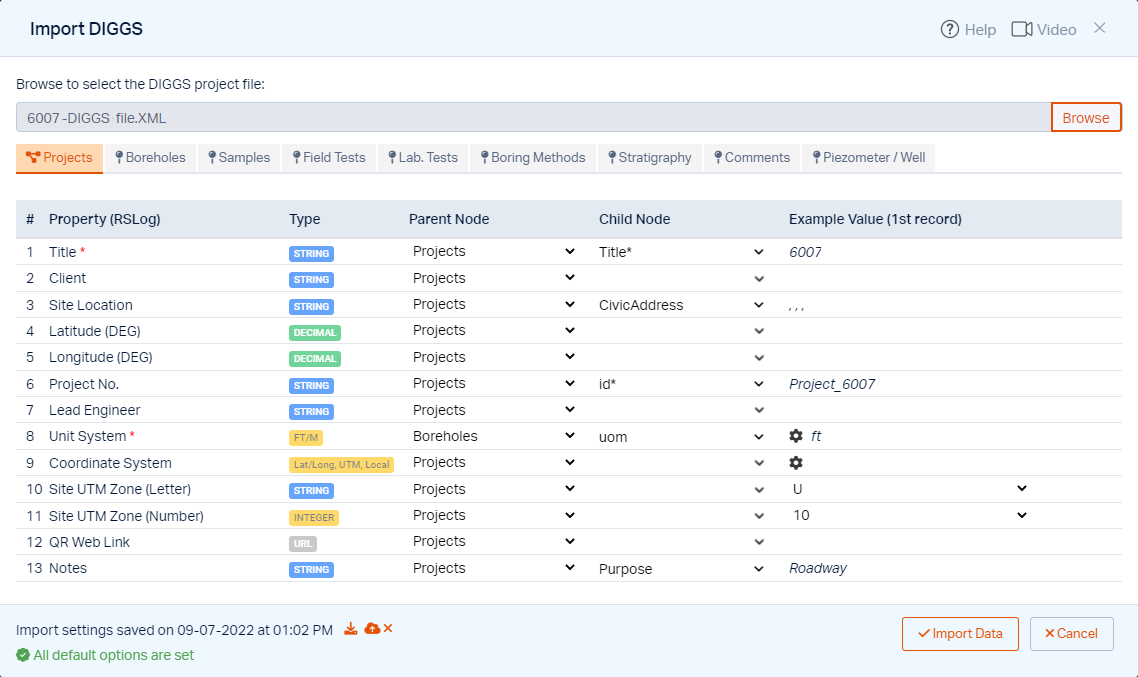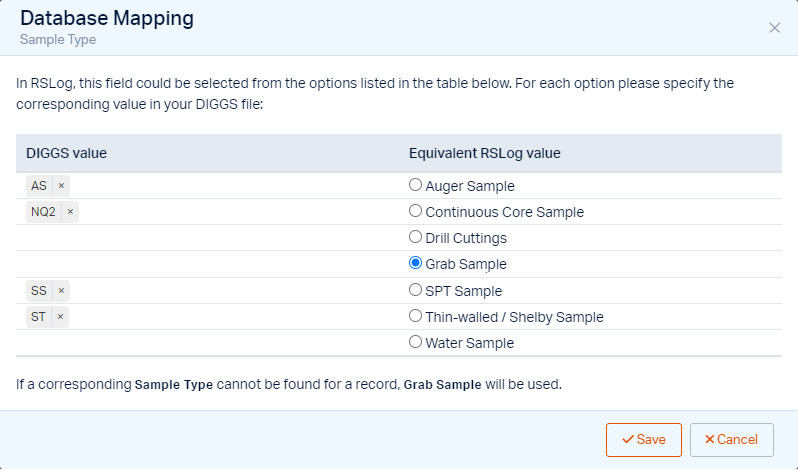DIGGS Import
The DIGGS Import feature is accessed from the left menu panel under the Import menu, and allows the user to import their project data from a DIGGS file to their RSLog account.
Requirements for DIGGS Import
This feature requires a DIGGS file (*.xml) prepared based on the latest DIGGS format.
Overview of DIGGS Import Process
This feature reads project data from the DIGGS file and writes data in your RSLog account. Due to the flexibility of DIGGS files, the import tool needs to know where in the DIGGS file specific data is stored. For example, most DIGGS files store Project Title in Projects parent node and Title child node. Using the DIGGS Import tool, there are two types of 'data mapping' that needs to be done:
- Simple Data Mapping: Simple data such as project name, borehole depth, etc. only require determining the 'parent node' and 'child node' in the DIGGS file where the data is stored.
- List Data Mapping: For more complex data types such as Sample Types, Soil Classification, Drilling Methods, etc. each item in the DIGGS list should be mapped to its corresponding 'type' in RSLog list. For example, in the DIGGS file you may have a sample type saved as "AUG", representing a soil sample taken from an auger flight during drilling. In your RSLog account you want to link this type of sample to RSLog Auger Sample.
When you open the DIGGS Import tool for the first time, the program automatically selects the default parent nodes and child nodes, however you will be able to review and edit this settings using the aforementioned two types of data mapping.
Selecting the DIGGS File
Click on the Browse button next to Choose DIGGS File to select your DIGGS project file. This will initiate data processing. Once completed, you will see several tabs on the DIGGS Import dialog.
List of Data Entities
Once your DIGGS file is processed, the dialog will show the list of Data Entities such as Projects, Boreholes, Samples, etc. in various tabs. Each tab shows the list of items ('properties') available for each Data Entity (see screenshot below). Each table is structured as follows:
- Property (RSLog): shows the name of the property for a specific RSLog data entity. For example, each project (as Data Entity) has a Title (as property).
- Type: the data type for each property is shown in this column.
- Parent Node: indicates the table in the gINT file where the data for this property is stored.
- Child Node: indicates the column (field) in the select gINT Table where the data for this property is stored.
- Example Value (1st Record): shows the actual value of the property for the first record in selected gINT Table.

Simple Data Mapping
The first time you use the DIGGS Import tool, the program automatically selects the default parent and child nodes for the most common data entities.
- Review /select the parent and child nodes for each item in the tables. You can use the example value shown in the last column to verify if the right combination of parent and child node is selected.
- Go through all the tabs and make sure that data mapping is completed for all data entities. Depending on the structure of your DIGGS files, some tabs may not be relevant. For example if piezometer data is available in your DIGGS file, you can skip settings for Piezometer/Well tab.
List Data Mapping
Where the value of a property in RSLog (e.g. project 'unit system') should be selected from a list of options, an ![]() icon will be displayed next to the child node dropdown. Clicking on this icon will open the Data Mapping page, allowing a user to link the DIGGS lookup lists to the RSLog lists.
icon will be displayed next to the child node dropdown. Clicking on this icon will open the Data Mapping page, allowing a user to link the DIGGS lookup lists to the RSLog lists.
The following screenshot shows an example of list data mapping for Sample Types. For each Equivalent RSLog value in the second column, the DIGGS sample type must be entered in the first column.

If you know the exact phrases used in your DIGGS data structure, enter it in the first column for each RSLog sample type. Please note by pressing Enter, the item is added to the list and you can start entering new item for the same RSLog value, if it is necessary. Once your data mapping is completed, click the Save button. Your settings will be saved under your account and next time you use the DIGGS Import tool, your settings will be loaded automatically.
Importing Data
Once all settings are completed, click on the Import Data button. This will create a new project in your RSLog account and all the 'mapped' data will be imported.
What Happens to the Unmapped Data?
The data that is not directly 'mapped' between your DIGGS file and RSLog account will be imported to your new RSLog project. This data is typically shown in Miscellaneous Data tab of each borehole.
Batch Import
This feature is under development and will be available soon.